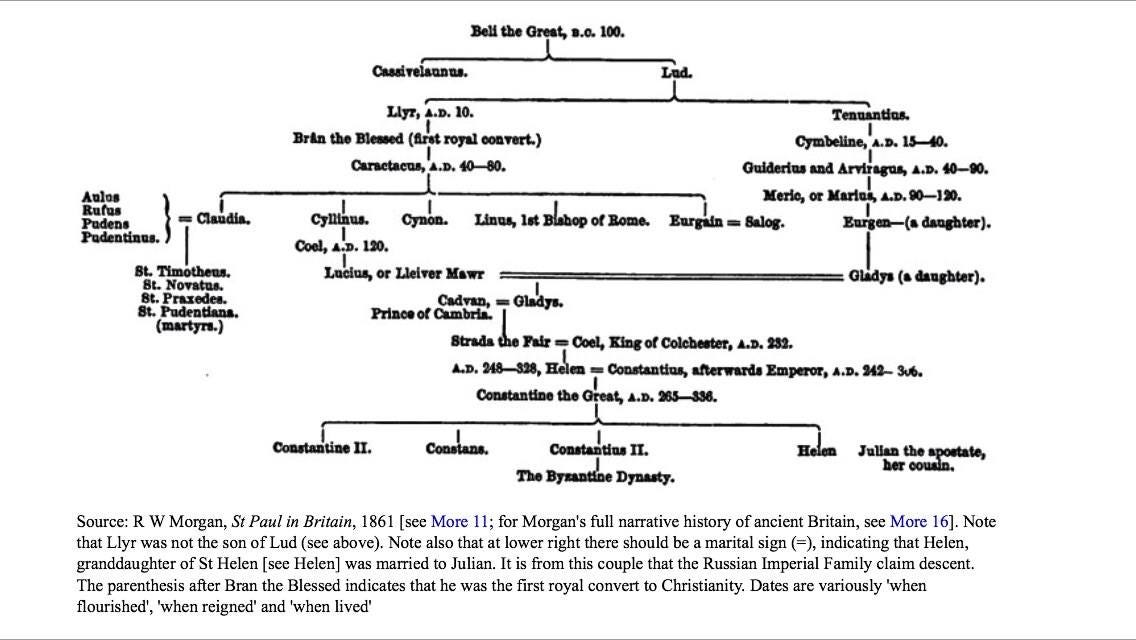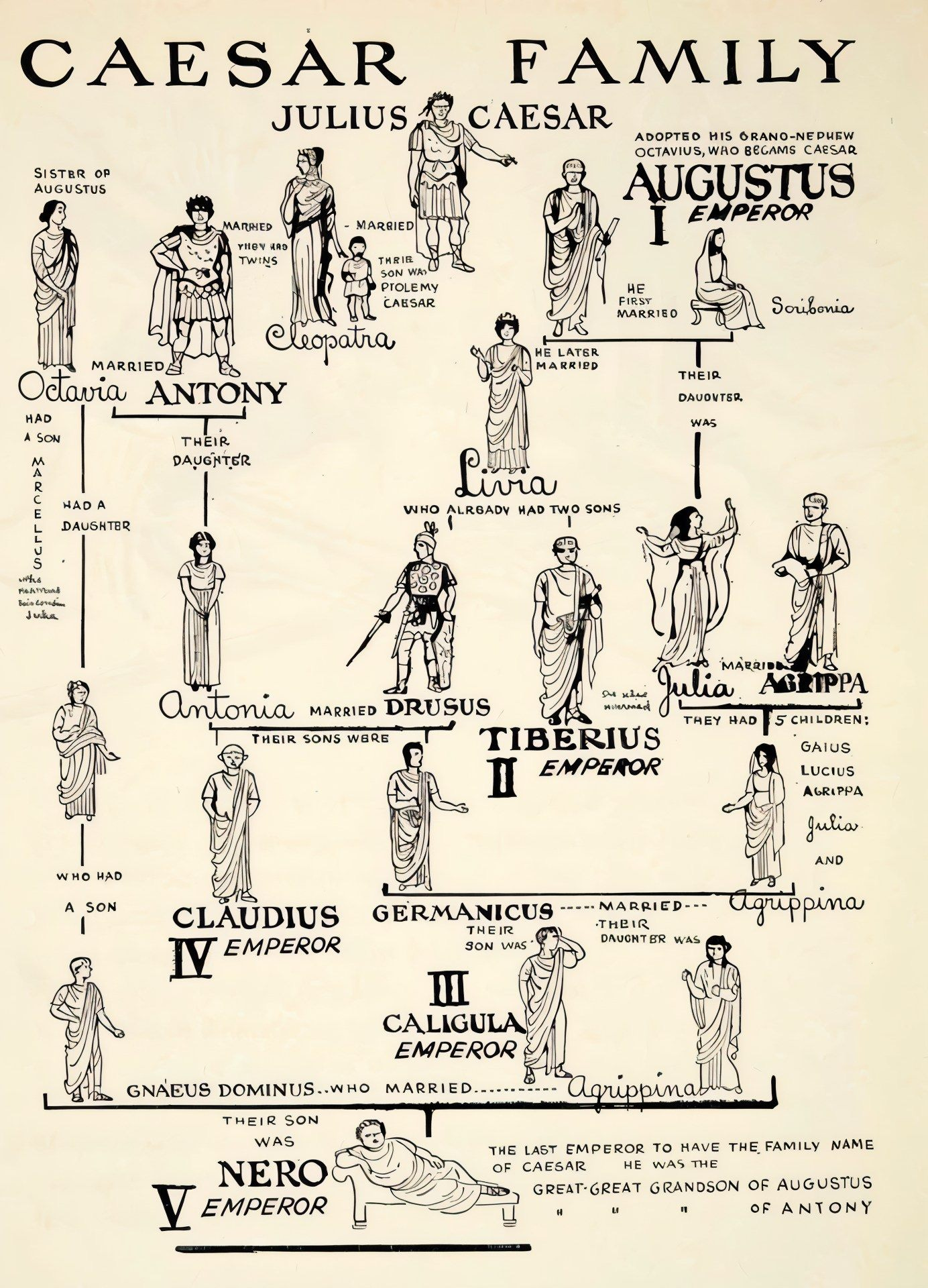Article preview (as being formatted for the https://www.Celtic.press newsletter) For those who like to study: the House of Este (male line of Brunswick) is listed in plenty of histories, with genealogical charts such as these, listing back to the Julian house of Caesar.
Queen Venissa (Genuissa), according to Geoffrey of Monmouth's 12th century Historia Regum Britanniae, was a daughter of the Roman Emperor Claudius, whom he gave in marriage to the British king Arvirargus after he had submitted to Rome.
She was referenced in Satire IV, a 2nd century satirical poem by Juvenal; as daughter of Roman Emperor Claudius given in marriage to the respected rival (As Chronicled by Tacitus as her husband won an appeal at Rome to have an unprecedented compromise to preserve the British Nobility rather than exterminate it, as was the standard practice).
Tudor period Britain produced a lot of works on this genealogy. This basis of the Nobility was basically the law of the land. It was indisputable at the period when people weren't trained in communism to hate anything related to heritage. I can wager to say, that the First Century basis of the British Royal family should again be restored as the standard. Once exposed to the facts, probably only those who are carry super anti-Nationalistic bias would still speak against it. The best point of all, is it proves the Bible covenants are true.
St Helena, the British Royal mother of Constantine, is of this branch.
We know of the other branches of the same, which culminate down to King Arthur in his genealogy.
Of course this was a main base of Christ's family as cataloged in the Holy Scriptures. These Imperial ladies, Pudens and Claudia, referenced by St Paul intermarried to Caesar's household, just as the
Scriptures and history described.
Here are some excerpts from our booklet on our early Celtic Saints of Britain, picking out a few of this line:
1. St. Joseph of Arimathea, the Apostle of Great Britain, received twelve hides of Glastonbury from King Avarigus (cousin of Caractacus). In AD58 St. Joseph of Arimathea was re-consecrated by St. Philip, now with the title “Chief Priest in Britain”. St. Paul joined St. Joseph in Britain, starting in the year 60AD. First Century Welsh, Judean, Persian, Egyptian, Spanish and Roman records describe his exploits commanding the Nazarene Galilean and Essenic “blue tunic army”, or the Culdee Priesthood. His coat of arms form the St. George Cross of Great Britain. Morgan’s history said after being exiled to Gaul with Lazarus and Mary Magdelene, he was joined by forty more from Jerusalem before setting sail to Britain. Alfwold’s history (authenticated by Vatican manuscripts of the archives retrieved by Emperor Theodosius at the palace of Pilate at Jerusalem) says Joseph came with six hundred companions upon a ship built by King Solomon together with the duke of the Medes, called Nacianus, formerly baptized by Joseph in the city Saram, with the king of it, called Mordraius, who valiantly killed a king of North Wales, who held Joseph prisoner, after which he and his companions preached in the area, and were granted the twelve hides by King Avarigus. Comm. Aug 31.
4. St. Bran the Blessed was born in Judea, and was a high King of Britain. He was consecrated by St. Paul as Bishop of Siluria, replacing his title of ArchDruid. “the St. Ynys Prydain, or Pedigrees of the Saints of Britain” agrees with the Welsh Triads in attributing the first introduction of Christianity to Bran. (The Ecclesiastical Antiquities of the Cymry; Or the Ancient British Church, J. Williams, M.A., Rector of Llanymowddwy.) He married Joseph’s daughter Anna, founding another Levitical line for Celtic priests. Comm. on numerous 3rd-5th Century Saints festivals, such as in the Silurian catalog with Aristobulus, his confessor or spiritual instructor (periglor).
7. Saint Anna of Arimathea the Prophetess, daughter of Joseph, of the Levitical/Aaronic lines of Zadok. Married Fendigaid 'The Blessed' ap Lllyr-Lear-Lediaith, and is ancestress of a long line of Saints and Royals. Feastday: March 17
8. St. Genuissa/Enygeus, sister of Joseph of Arimathea, married King Arvarigus, and is ancestress of a long line of Welsh (Hebrew) Saints and Royals.
15. St. Eigra (AKA Eurgain) of Llan Ilid, was sister of Caractacus, daughter of Caradog ap Bran, and wife of Salog, Lord of Caer Salog (Salisbury), the first female St. in Britain (Morgan, History of Great Britain). She co-founded the religious college of twelve named Cor Eurgain (the choir of Eurgain) at Llan. From this choir (or Cor-Eugain) issued many of the most eminent teachers and missionaries of Christianity down to the tenth century, as catalogued in “Genealogies of the Saints of Britain”, listing from “Illid the Hebrew”, St. Illid, who came with Bran the Blessed from Rome at the request of Eurgain was made the chief instructor of the choir. She is an ancestor of St. Helen (mother of Constantine) and feast date is June 29th.
16. St. Rufus Pudens married the British princess Claudia (Gladys). His home in Rome was called Palatium Britannica, also the previous residence of British royals, and house of worship. Father of Praxedes and Pudentiana. He was clothed with baptism by the apostles, and watched and kept is robe pure and without wrinkle to the crown of a blameless life. Comm. May 17.
17. St. Pudentiana, the virgin, of the most illustrious descent, daughter of Pudens, and disciple of the holy apostle St. Paul. Comm. May 17.
You may wish to study the chapter on St Joseph of Arimathea from my book, Sabbath Rest, where the most evidence of manuscripts are disclosed in one writing: https://celticorthodoxy.com/2015/05/honoring-of-the-sabbath-in-the-historic-orthodox-church/ For A Traditional Britain Traditional Britain Group - Lifeboat British Israel Book Club (Celto-Saxon True Israel) British Israel for Identity believers British Israel Celto-Saxon & Kindred Faithful, Matt 15:24 - True Israelites II (revived)
Attachments:



![May be an image of text that says 'ancient Houfe EAe livedin Rame ACTTUS. inceof 410 LUCIUS RENESTUS 4nSceffors SABINUS. Guelpbr. Franks d. 425- ALPHORISIUS 430. SEVERIANUS. Franks Anceftors ACHARINUS 58 Witekind VAUBERTUS Be Great. OF Mifelle. Mefelle. Birth WAMBERTU CONSTANTIUS 90. ฮลพะ BASILIUS. 564- Time GUNDELHARDUS. REGENFRIED Birth Carioingian Chrilt AELHARDUS, 655 d . eofEfePrince HUNIBALDUS. GODFREY. Domus OTHO. BERENGARIUS 4. lived Prince HUNIBERTUS. ADELONGUS. 8gt. ENNDISIUS 90. 256. Sawong HUGO SIEGFRIED. ARDUINUS. Domus, furnamel م 350. THEOBALD. GERHARD. ALMERICUS ADELBERTUS Duke Duke THEODORIC. CONRAD. 741 allo BONIFACIUS, HUGO ofKent. RONIX married Guripor. Matbuldis HULDERICUS GUELPH. ftill Sa美sa] King AZO. 633- Tabir 691. King នរ Talle' May be an image of text that says 'ancient Houfe EAe livedin Rame ACTTUS. inceof 410 LUCIUS RENESTUS 4nSceffors SABINUS. Guelpbr. Franks d. 425- ALPHORISIUS 430. SEVERIANUS. Franks Anceftors ACHARINUS 58 Witekind VAUBERTUS Be Great. OF Mifelle. Mefelle. Birth WAMBERTU CONSTANTIUS 90. ฮลพะ BASILIUS. 564- Time GUNDELHARDUS. REGENFRIED Birth Carioingian Chrilt AELHARDUS, 655 d . eofEfePrince HUNIBALDUS. GODFREY. Domus OTHO. BERENGARIUS 4. lived Prince HUNIBERTUS. ADELONGUS. 8gt. ENNDISIUS 90. 256. Sawong HUGO SIEGFRIED. ARDUINUS. Domus, furnamel م 350. THEOBALD. GERHARD. ALMERICUS ADELBERTUS Duke Duke THEODORIC. CONRAD. 741 allo BONIFACIUS, HUGO ofKent. RONIX married Guripor. Matbuldis HULDERICUS GUELPH. ftill Sa美sa] King AZO. 633- Tabir 691. King នរ Talle'](https://substackcdn.com/image/fetch/$s_!fKVD!,w_1456,c_limit,f_auto,q_auto:good,fl_progressive:steep/https%3A%2F%2Fsubstack-post-media.s3.amazonaws.com%2Fpublic%2Fimages%2F9d3ba7d8-5d3f-4359-86a0-f686bb9e0dbb_1676x843.jpeg)




